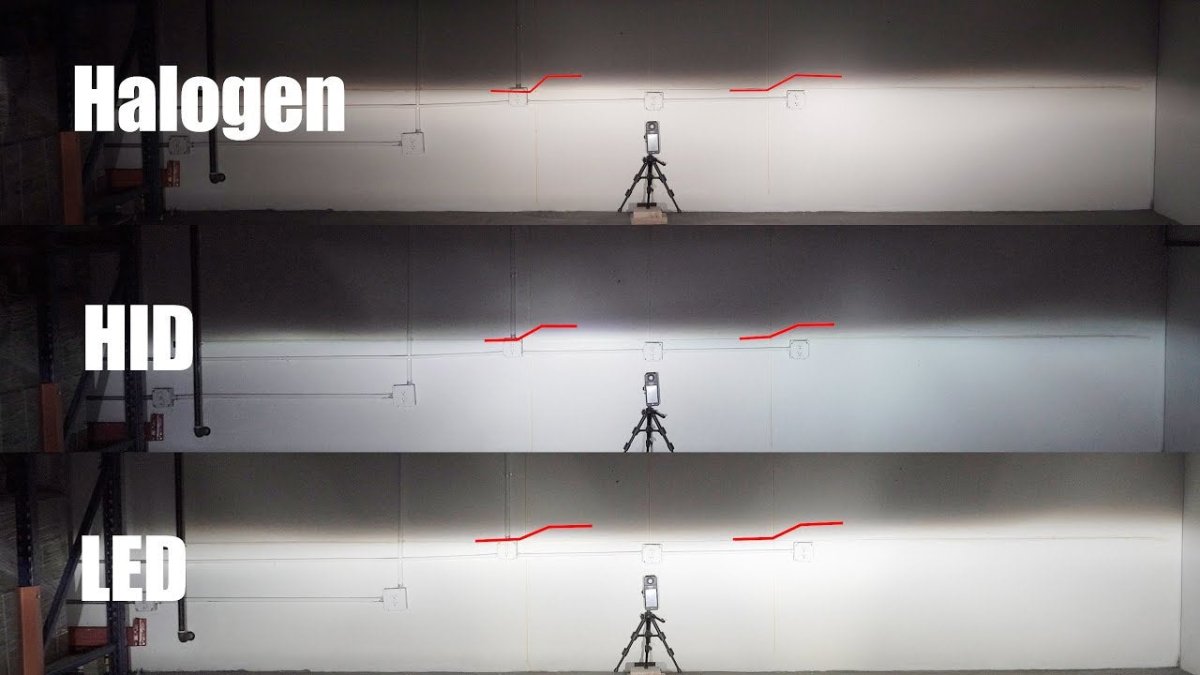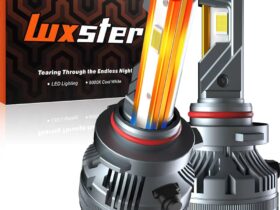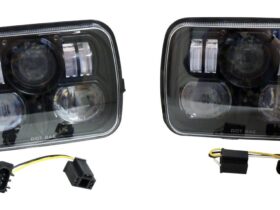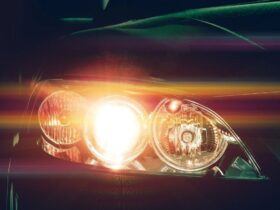HID vs LED Headlights: HID headlights offer intense brightness and efficiency, while LED headlights provide longevity and energy savings. Both have distinct benefits in automotive lighting, making the choice between them crucial for your vehicle.
Car manufacturers and drivers often debate the superiority of HID headlights VS LED (Light Emitting Diode) headlights. HID lights, known for their high luminance and color temperature, revolutionized driving visibility when they first appeared. On the other hand, LED headlights have gained popularity for their low power consumption and longer lifespan, making them a cost-effective option over time.
They also allow for versatile design, enabling manufacturers to craft unique headlight signatures for aesthetic appeal. Car enthusiasts weigh these advantages against each other, taking into consideration factors like the vehicle’s design, the driver’s preferences, and the local driving conditions to choose the optimal lighting solution. Moreover, both technologies continue to evolve, constantly pushing the envelope in automotive illumination.
The Evolution Of Automotive Lighting
The Evolution of Automotive Lighting has revolutionized the way we drive after dark, ushering in safer, more efficient, and then visually appealing experiences on the road. Moreover, from the earliest days of motoring, where visibility was minimal, to the high-tech illumination of today’s roads, vehicle lighting has undergone a significant metamorphosis.
The journey from flickering candlelight to bright LEDs is not only a tale of innovation but also ingenuity. Initially, automotive lighting began with simple oil lamps that offered a dim glow. However, as technology advanced, the invention of the electric bulb in the early 20th century was a game-changer. This breakthrough led to the development of the first electric headlights and then marked a major leap forward in automotive illumination technology.
Advancements In Headlight Technology
- Sealed beam headlights in the 1940s: Improved durability and reliability
- Halogens in the 1960s: Offered brighter, and obviously more efficient light
- High-intensity discharge (HID) lamps in the 1990s: Greater light output and efficiency
- Light-emitting diodes (LEDs) in the early 2000s: Low energy consumption, longevity, and finally versatility
Each era brought remarkable breakthroughs in headlight technology. Furthermore, early advancements saw light reach farther into the darkness, making night driving safer and more comfortable for motorists. Later on, adaptive headlight systems emerged, which can adjust the beam direction based on driving conditions.
| Year | Innovation | Impact |
|---|---|---|
| 1983 | HID/Xenon headlights | Enhanced brightness and road visibility |
| 2004 | Adaptive front-lighting systems (AFS) | Improved visibility around corners and slopes |
| 2007 | Full LED headlights | Energy efficiency and design flexibility |
| 2013 | Laser headlights | Superior range for high-beam settings |
LEDs and HIDs are two of the most popular options on modern vehicles. While HID headlights are known for their brightness, LEDs boast energy efficiency and long life. Both types have played significant roles in enhancing driver safety and vehicle performance.
In essence, the evolution of automotive lighting is a story of brighter, smarter, and more energy-efficient innovations. It continues to evolve, promising a future where headlights offer not just visibility but also enhanced driver assistance.
Fundamental Differences Between HID VS LED Headlights
Understanding the key differences between HID and LED headlights is crucial for making an informed decision about your vehicle’s lighting. Moreover, when it comes to brightness, longevity, energy efficiency, and ease of installation, HID and LED lights vary significantly. Additionally, let’s explore the mechanics behind each type and how they affect your driving experience.
How Hid Headlights Work
HID, or High-Intensity Discharge lamps, use a mix of gases and metal salts to produce light. Furthermore, an electric charge passes through this gas, creating a bright white or blue glow. Additionally, HID headlights are known for their impressive light output and effective road illumination.
- Electric charge ignites gas and salts
- Bright light from the reaction
- Effective road coverage for safety
The Technology Behind Led Lights
LED, or Light light-emitting diodes, operate by passing an electrical current through a semiconductor material. Additionally, this action emits photons, which we see as light. Moreover, these headlights are distinguished by their energy efficiency, long life, and compact design.
- Electric current through diodes
- Photons released as light
- Energy efficient and long-lasting
| Aspect | HID Headlights | LED Headlights |
|---|---|---|
| Brightness | Very Bright | Bright |
| Longevity | Long-lasting | Longer-lasting |
| Energy Efficiency | Less Efficient | Highly Efficient |
| Installation | Complex | Simpler |
Brightness And Visibility On The Road
Brightness and visibility on the road are vital for safe driving after dark. Moreover, headlights not only help you see where you’re going, but they also make sure other drivers can see you. Additionally, two popular choices for headlights are High-Intensity Discharge (HID) and Light Emitting Diodes (LED). Moreover, let’s compare their brightness and how they affect visibility, thereby facilitating better, safer driving at night.
Lumens And Intensity: HID Vs LED Headlights
The brightness of a headlight is measured in lumens. Moreover, the higher the lumens, the brighter the light. Additionally, HID headlights can produce a bright luminous intensity in a range of 3,000 to 5,000 lumens on average. Furthermore, LED headlights usually emit a similar range, but they consume less power.
Look at this comparison table for an easy overview:
| Type | Average Lumens | Power Consumption |
|---|---|---|
| HID Headlights | 3,000 – 5,000 | Higher |
| LED Headlights | 3,000 – 5,000 | Lower |
Beam Patterns: Safety And Coverage
The beam pattern is not only just as important but also brightness is necessary. Additionally, a good beam pattern increases safety for everyone on the road. Moreover, HID headlights sometimes create a less focused beam, which can cause glare to other drivers. However, in contrast, LEDs provide a more controlled beam pattern, helping to better illuminate the road without blinding other drivers.
- HID Headlights – Wider beams can cause glare.
- LED Headlights – Directed beam reduces glare.
Proper alignment is crucial for both HID and LED headlights as it ensures optimal coverage and driver safety. Therefore, make sure to have your headlights checked and adjusted regularly to maintain peak performance.
Energy Efficiency: The Power Consumption Battle
To whittle down the options for the most energy-efficient headlights because a dive into HID vs. LED is essential. Car enthusiasts often ponder over which headlights reign supreme when it comes to power consumption.
Through this exploration, not only do we unveil the winner of the brightness battle but also shed light on which choice promises a gentler tug on your vehicle’s electrical resources.
Comparing The Electrical Draw Of Hid VS Led Headlights
HID (High-Intensity Discharge) and LED (Light Emitting Diode) headlights differ greatly in their power usage. While both aim to illuminate your path, their electrical draw is a pivotal factor that sets them apart.
| Headlight Type | Power Consumption (Watts) |
|---|---|
| HID Headlights | Between 35-85 watts |
| LED Headlights | About 20-30 watts |
With LEDs using significantly less power than HIDs, the energy-saving advantages are clear. Furthermore Such efficiency can translate to longer lifespan and less strain on the vehicle’s electrical system.
The Impact On Vehicle Battery And Alternator
The choice between HID and LED headlights hinges significantly on their impact on a car’s battery and alternator, crucial factors to consider for optimal vehicle performance. Furthermore, headlights are a key draw on these components, directly influencing their longevity and performance.
- Lower power consumption of LEDs means less battery drain.
- An alternator works less with LEDs, reducing wear.
- HIDs potentially cause more frequent alternator load and wear.
For these reasons, many drivers find that LED headlights offer a balance between efficiency and performance. Additionally, opting for LEDs could mean fewer trips to the mechanic for battery or alternator issues, enhancing both convenience and reliability.
Longevity And Durability In Harsh Conditions
Headlight longevity and durability matter.
Drivers want reliable lights not only in all weather but also in terrains.
Let’s compare HID and LED headlights.
Life Expectancy Of HID Vs LED Headlights
- HIDs usually last for about 2,000 hours.
- LEDs shine longer, often more than 5,000 hours.
LEDs win in life expectancy.
Resistance To Vibration And Weather: HID VS LED Headlights
Harsh conditions test headlights.
Therefore, Vibrations and extreme weather can cause damage.
| Headlight Type | Vibration Resistance | Weather Resistance |
|---|---|---|
| HID | Good | Fair |
| LED | Excellent | Excellent |
LEDs handle bumps and temperature swings better than HIDs.
Installation And Maintenance Considerations: HID vs LED Headlights
Choosing the right headlights involves not just brightness but also how easy they are to install and maintain. However, HID and LED headlights differ greatly in both aspects. Moreover, in this section, we dive into the installation and maintenance considerations for these popular options, ensuring you can make an informed decision for your vehicle.
Ease Of Installation For Diy Enthusiasts
Installing new headlights can be a weekend project. But here’s what to expect with HID and LED options:
- Firstly, LED headlights are often a direct plug-and-play solution. Moreover, most cars find this option super easy to install, making it an attractive choice for vehicle owners.
- Secondly, HID headlights may require a few extra steps. Additionally, these might include mounting a ballast and ensuring proper wiring. Consequently, some cars might need professional help to complete the installation process.
Consider your comfort level with car maintenance before deciding. And then LEDs usually win for simplicity.
Ongoing Care And Replacement Costs
After installation, think about the future needs of your headlights. Besides both types have different care needs:
| Type | Care Needs | Replacement Costs |
|---|---|---|
| LED | Little to no maintenance, due to a long lifespan. | Higher upfront, but less frequent replacements needed. |
| HID | May require adjustments and obviously cleaning of components. | Lower upfront, but more frequent replacements. |
LEDs often last the car’s lifetime, meaning less worry about replacements. HIDs, while cheaper initially, could end up costing more over time with more frequent changes. Always consider both the short-term and long-term commitment when choosing your headlights.
Cost Analysis: Upfront And Long-term Expenses
When considering upgrading your vehicle’s headlights, evaluating both upfront and long-term costs is crucial. Therefore, do HID or LED headlights offer more value over time? Additionally, this cost analysis dives into the initial investment and the total cost of ownership to help car owners make informed decisions.
Initial Investment Comparison
Moreover, HID (High-Intensity Discharge) headlights and LED (Light Emitting Diode) headlights carry distinct price tags at purchase. Additionally, comparing these costs is the first step.
| Headlight Type | Cost Range |
|---|---|
| HID Headlights | $70 – $150 |
| LED Headlights | $100 – $300 |
LED headlights tend to be pricier upfront compared to HIDs. Still, price is just one part of the equation.
Assessing The Total Cost Of Ownership
Looking beyond the initial price, it is essential to consider the long-term costs and benefits when choosing headlights for your vehicle.Moreover, the total cost of ownership encompasses lifespan, energy usage, and maintenance.
- HIDs last around 2,000 hours.
- LEDs can shine for up to 20,000 hours.
Firstly, Consider energy efficiency as well. Additionally, LEDs win by using less power, resulting in long-term savings.
But maintenance should not be ignored. Frequent replacement and higher chances of failure make HIDs more demanding in the long run. As a result, LEDs shine with minimal upkeep.
| Factor | HID | LED |
|---|---|---|
| Lifespan | Shorter | Longer |
| Energy Efficiency | Lower | Higher |
| Maintenance | More Often | Less Often |
Factor in these aspects and LEDs often present a more economical choice over their lifetime, despite the higher initial cost.
Aesthetics And Customization Options
When it comes to vehicle headlights, looks matter as much as performance. Furthermore, the aesthetics and customization options of HID and LED headlights offer car enthusiasts a way to make a statement. Additionally, with different lighting options, drivers can create a unique look that stands out from the crowd, enhancing the vehicle’s overall appearance.
Personalizing Your Ride With Headlight Choices
When choosing headlights, it reflects personal style. Some prefer the bright, crisp illumination of LEDs, while others opt for the distinct blue-white glow of HIDs. Consequently, here’s how both options can customize your vehicle:
- LEDs come in various colors, so allowing for creative expression.
- HIDs offer a customizable light spectrum for a personalized touch.
- Replacement kits enable easy switches between styles.
Cultural Trends: The Look Of Modern Headlights
Headlights have become a statement in car culture. Additionally, they are not just for night vision; they reflect modern design trends, contributing to the overall aesthetic appeal of the vehicle.
| HID Headlights | LED Headlights |
|---|---|
| Give a bold, distinctive glow. | Sharp, defined lighting patterns catch eyes on the road. |
| High-intensity for a powerful look. | Eco-friendly with a tech-savvy appeal. |
Contemporary vehicles often feature LEDs due to their long life and adaptability. Nevertheless, HIDs remain popular for those favoring an intense, high-performance image. Additionally, each type of headlight brings its own flair to vehicle aesthetics, contributing to the unique character of your ride.
Heat Emission And Cooling Requirements
When picking the right headlights, the heat they emit is crucial. Additionally, two popular choices are HID and LED headlights, each with their own characteristics and benefits to consider. Both types need good cooling to work well and last long.
Thermal Management In Hid Systems
HID VS LED Headlights refers to High-Intensity Discharge. Moreover, these lights generate significant heat. Additionally, to manage this, they incorporate special components designed to dissipate heat effectively.
- Fans: Move air to cool the bulbs.
- Heat sinks: Metal parts that take heat away from the bulb.
Good cooling means HIDs last longer. Without it, the heat can also damage the bulb quickly.
Advancements In Led Cooling Techniques
LEDs stand for Light Emitting Diodes. Additionally, these are modern lights that use less power and make less heat compared to traditional lighting technologies. But, they still need to stay cool.
New technologies keep LEDs cool:
- Braided Heat Sinks
- Firstly, flexible and improve airflow.
- Heat Pipes
- Secondly, carry heat away from the LED chips.
- Advanced Materials
- Finally, Materials like copper and aluminum spread the heat better.
With these cooling methods, LEDs can work better for longer.

Credit: www.amazon.com
Compatibility With Advanced Driver-assistance Systems
Modern vehicles boast cutting-edge technology for safety and comfort. Moreover, Advanced Driver-Assistance Systems (ADAS) rely heavily on a vehicle’s lighting system, highlighting the importance of reliable and efficient headlights for overall vehicle safety. Headlights, especially HID and LED, play a crucial role in these systems. Let’s delve into how these headlights fare with ADAS.
Interfacing Headlights With Vehicle Electronics
Vehicle electronics are the brains behind ADAS. Additionally, they need to communicate effectively with all parts, including headlights. Moreover, this need for flawless interaction puts the spotlight on HID vs LED headlights, as both need to integrate with vehicle electronics seamlessly to ensure optimal performance and safety.
- HID headlights, known for their high intensity, certainly, must adjust quickly to changing conditions.
- LED headlights, are praised for efficiency, and then require proper interfacing to function in tandem with sensors and cameras.
Both options impact how well the vehicle senses and reacts to its environment.
The Role Of Lighting In Autonomous Features
As we steer closer to fully autonomous driving, the role of lighting becomes more profound. Additionally, headlights are not just for vision; they facilitate critical sensing functions for automation, underscoring their significance in the evolution of automotive technology.
- LED lights provide consistent brightness and pattern, and eventually enhancing camera vision.
- HID lights, with their broad spectrum, aid in detecting obstacles and road signs.
- Both HID and LED headlights must be precisely controlled to avoid interference with the vehicle’s sensing capabilities. Indeed, this meticulous control guarantees that advanced driver-assistance systems (ADAS) and other safety features can function optimally without any interference from the emissions of the headlights.
Proper calibration of headlights is essential to ensure the functionality of ADAS.
Impact On Driving Experience And Comfort: HID VS LED Headlights
The right headlights can transform your driving experience, equally making it safer and more comfortable. When considering HID (High-Intensity Discharge) versus LED (Light Emitting Diode) headlight options, it’s vital to evaluate how they affect visibility and driver comfort. This takes us through the heart of the night road – the battle between brightness and endurance.
Reducing Glare And Improving Night Visibility
- HID headlights produce a bright, white light that closely resembles daylight. Additionally, this sharply enhances night visibility, providing clearer illumination of the road ahead.
- However, they can cause glare to oncoming traffic, which is a critical safety concern.
- In contrast, LED headlights provide a focused beam of light. This helps reduce glare while still offering ample road illumination.
A well-lit road lets you see further and clearer. This prevents accidents and ensures a peaceful drive.
Driver Fatigue: The Importance Of Appropriate Lighting
- With LED headlights, drivers enjoy a consistent light output. Additionally, this minimizes eye strain and battles driver fatigue, enhancing overall comfort and safety during extended periods of driving.
- HID headlights, though brighter, may flicker over time. This flickering can cause significant eye strain.
Long drives demand consistent, comfortable lighting. Moreover, this helps keep the driver alert and reduces the risk of fatigue-related mistakes, promoting safer and more enjoyable journeys.

Credit: allalighting.com
Environmental Considerations
As we search for ways to lower our carbon footprints, we also look at our car’s headlights. The headlights we choose can indeed impact the environment. Moreover, let’s explore the eco-side of HID and LED headlights, considering factors such as energy efficiency, longevity, recyclability, and overall environmental footprint.
Eco-friendliness: Hid Vs Led Headlights
When we talk about headlights, two popular types are HID (High-Intensity Discharge) and LED (Light-Emitting Diode). Both have unique impacts on the earth.
- HID headlights use gas and a mixture of rare metals. This uses more power.
- LED headlights, on the other hand, use solid-state technology. They need less power and last longer.
Between HID vs LED, LED headlights win for being more eco-friendly. Additionally, they conserve energy and reduce waste by lasting longer, contributing to a more sustainable automotive lighting solution.
Disposal And Recycling Of Headlights: HID VS LED Headlights
Moreover, We must think about how to toss old headlights. However, Safe disposal is key to not harming the planet.
| Type | Disposal | Recycling |
|---|---|---|
| HID | Needs careful disposal due to hazardous materials. | Can be complex, as metals and gas must be handled correctly. |
| LED | Easier to dispose of because of non-toxic materials. | More recyclable with existing tech. |
LED headlights are simpler to dispose of and can often be recycled, making them the greener choice. Additionally, always follow your local rules for disposal and recycling of headlights to ensure proper environmental stewardship.
The Role Of Regulations In Headlight Technology
Headlight technology has indeed made significant advancements over the years, transitioning from traditional halogen bulbs to more advanced HID (High-Intensity Discharge) and LED (Light Emitting Diode) systems. Moreover, legislative guidelines play a crucial role in shaping how these technologies are used in vehicles, ensuring safety and standardization on roads globally. Additionally, let’s delve into how global standards and legislation direct the course of headlight designs.
Compliance With Global Standards
Manufacturers must meet international headlight standards to sell their vehicles across different countries. Additionally, these standards are not static; they evolve with advancements in technology and safety research, ensuring that vehicles on the road adhere to the latest safety standards.
- ECE regulations in European countries
- FMVSS guidelines in the United States
- Requirements set by UN for worldwide markets
Compliance ensures that HID and LED headlights perform within certain brightness and color specifications. Moreover, this minimizes the risk of blinding oncoming traffic and maximizes the driver’s viewing distance, contributing to overall road safety.
How Legislation Influences Headlight Design
Legislation not only applies to the performance of headlights but also to their design and functionality. Innovation in headlight technology is often driven by these legal requirements.
- Adaptive lighting systems that adjust based on driving conditions
- Glare-free high beams providing illumination without affecting other motorists
- Automatic level control systems for consistent beam placement
These features come to life through a blend of engineering prowess and regulatory compliance. Additionally, this demonstrates the symbiotic relationship between technology and law, highlighting how advancements in one area often necessitate corresponding developments in the other to ensure safe and efficient operation.
Consumer Preferences And Market Trends: HID VS LED Headlights
When it comes to car headlight technology, two types reign supreme: HID and LED. Both have their tribes of followers. Additionally, with evolving market trends showing off different perks, car owners are keen to make the enlightened choice. Moreover, here’s a look at what consumers want and how the two technologies stack up in popularity.
Surveying Drivers: What They Want From Their Headlights
Diving into the driver’s seat, it’s clear what features take the spotlight:
- Brightness: Everyone wants to see the road well.
- Longevity: Fewer replacements mean more savings.
- Energy Efficiency: Keeping the power draw low is key.
- Style: Lights that look cool win extra points.
These preferences guide buyers towards the best headlight options for their vehicles, ensuring they prioritize factors such as brightness, longevity, energy efficiency, and overall performance.
The Popularity Contest: Hid Vs Led Headlights
| Feature | HID Headlights | LED Headlights |
|---|---|---|
| Brightness | Very bright | Comparable, with more focus |
| Lifespan | Long | Longer |
| Energy Consumption | Higher | Lower |
| Installation | Professional needed | DIY possible |
| Cost | Less expensive upfront | More cost-effective long-term |
In the tilt for the top, LEDs are pacing ahead. With their longer life and energy thriftiness, LEDs are swiftly becoming the favorite. That being said, some drivers still champion HIDs for their piercing luminosity and lower initial cost. And then technologies evolve, the market reacts, shaping trends that cater to these preferences. Additionally, it’s a headlight horserace where the brightest technology wins, and right now, LEDs are in the lead.
Expert Opinions And Industry Insights
When choosing the best headlights for your vehicle, the debate between High-Intensity Discharge (HID) and Light Emitting Diode (LED) headlights takes center stage. Additionally, recent discussions among experts provide valuable insights into the strengths and limitations of each technology. Finally, industry professionals give us a clearer view of what each headlight offers and what the future holds, helping consumers make informed decisions when selecting headlights for their vehicles.
Techn
icians Weigh In: Hid And Led Upsides And Downsides
Automotive technicians have first-hand experience with both HID and LED headlights. Moreover, they offer practical insights into the performance and longevity of these lighting systems.
| HID Headlights | LED Headlights |
|---|---|
|
|
Innovators Speak: The Future Of Headlight Tech
Lead designers and engineers in the automotive lighting sector are pushing the envelope. Furthermore, they are exploring how advancements in technology can transform headlight capabilities, driving innovation and shaping the future of automotive lighting.
- Smart headlights adapt to driving conditions
- Integration with sensors for autonomous driving
- Breakthroughs in LED efficiency to lower costs and enhance performance
- Developing organic LEDs (OLEDs) for more flexible headlight designs
Making The Best Choice For Your Vehicle: HID vs LED Headlights
Choosing the perfect headlights for your vehicle is critical for both safety and performance. Additionally, High-Intensity Discharge (HID) and Light Emitting Diode (LED) are the front runners in automobile headlight technology. Therefore, understanding their differences and assessing your specific needs is essential for making an informed decision. This decision influences visibility on the road, energy consumption, and overall driving experience.
Assessing Your Specific Needs
Before deciding between HID and LED headlights, consider these factors:
- Visibility: Determine the amount of light you require based on your typical driving conditions for optimal safety.
- Energy Efficiency: Compare the energy consumption of HID and LED lights.
- Longevity: Think about how often you want to replace your headlights.
- Installation: Know the ease of installing the headlights on your vehicle beforehand.
Drivers who often travel at night might opt for the brilliant illumination that HID lights provide, as the intense brightness can significantly enhance visibility during nighttime driving. Additionally, those looking for longevity and less energy usage might lean towards LEDs, showcasing the diverse preferences and priorities of consumers in selecting the ideal headlight technology for their needs.
Final Recommendations: Selecting The Right Headlights
After assessing your needs, consider these final recommendations:
| Headlight Type | Visibility | Energy Efficiency | Longevity | Installation |
|---|---|---|---|---|
| HID | High | Medium | Lower | Complex |
| LED | Medium | High | Higher | Simple |
For maximum visibility, HIDs might indeed be the best choice. However, LEDs are superior in terms of energy consumption and lifespan, and they are generally easier to install. Therefore, weigh these attributes against your requirements to ensure the optimal selection for your vehicle, facilitating informed decision-making.

Credit: www.groweliteled.com
Frequently Asked Questions For Hid Vs Led Headlights
What Are The Differences Between Hid vs Led Headlights?
HID (High-Intensity Discharge) headlights emit light through gas discharge, producing bright white or blue-toned light as a result. Additionally, LED (Light Emitting Diode) headlights use semiconductors to produce light, offering energy efficiency and a longer lifespan. Moreover, they typically emit a bright, white light, providing clarity and visibility on the road.
How Do Hid Headlights Compare To Leds In Longevity?
Generally, LED headlights outlast HIDs. LEDs can last for about 15,000 to 20,000 hours, whereas HIDs have a lifespan of about 2,000 to 10,000 hours. Moreover, LED’s longer lifespan means less frequent replacements and better durability.
Which Headlights Are Better For Night Driving, Hid Or Led?
LED headlights are often considered better for night driving due to their wider range of light, improved brightness and clarity, and immediate illumination. HIDs still provide intense brightness but may not be as sharp as LEDs.
Are Hid Or Led Headlights More Energy-efficient?
LED headlights are more energy-efficient compared to HIDs. LEDs use less power and convert more energy into light, not heat; therefore, making them the greener choice for vehicle headlights.
Conclusion
When deciding between HID and LED headlights, it ultimately comes down to your driving needs, budget, and preference for brightness or longevity. Whether you lean towards the intense illumination of HIDs or the efficient durability of LEDs, both options promise a clearer path on the road.
Your choice ensures a safer, more enjoyable driving experience.











Leave a Review